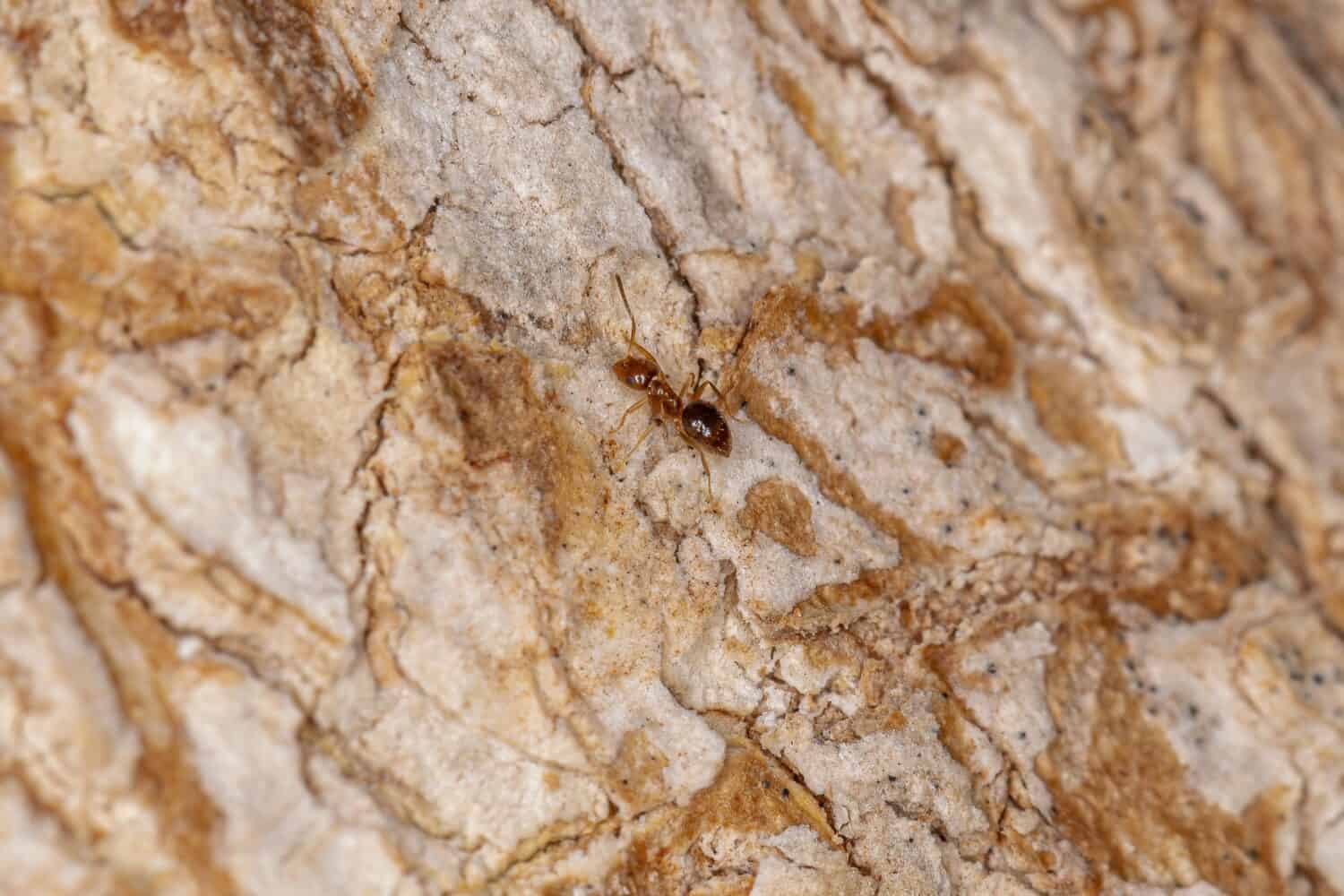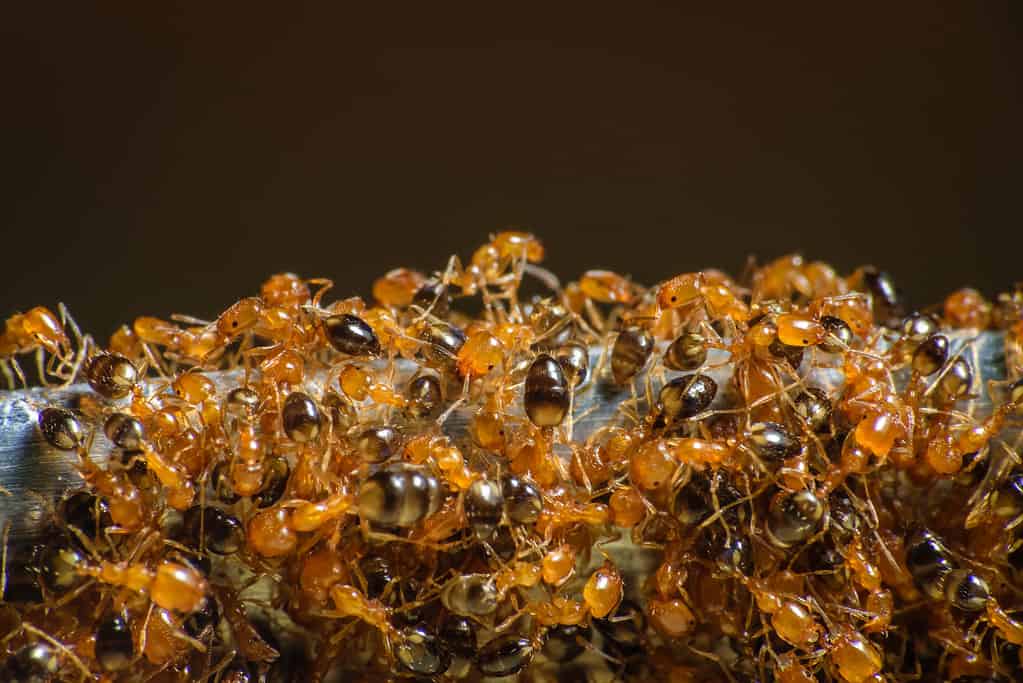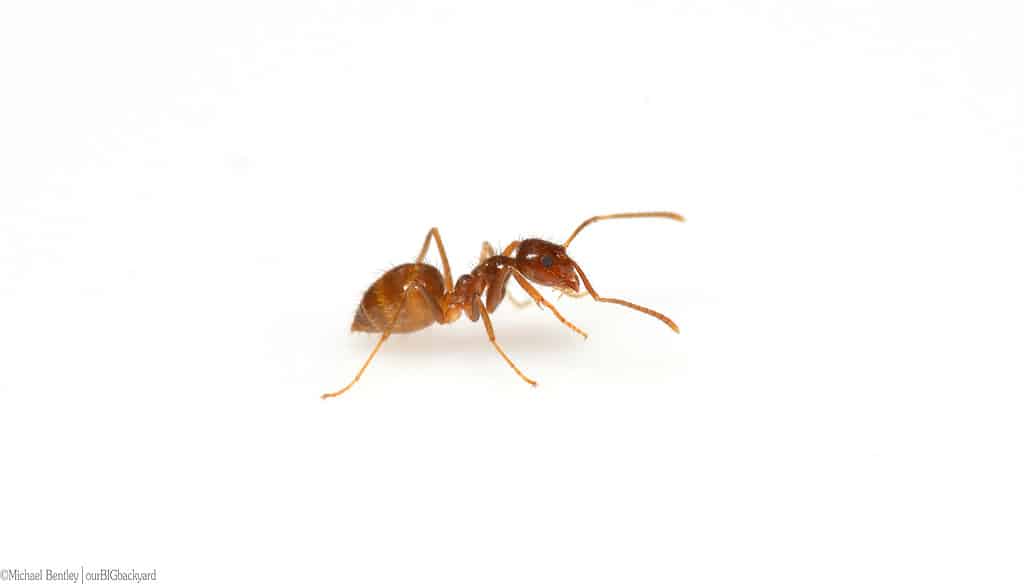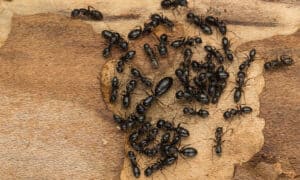
Summer in Texas is a time for swimming, hiking, barbequing…and battling invasive ants. These six-legged insects from the family Formicidae make a persistent nuisance of themselves in homes and gardens across the state. Some species can also cause damage to local plant life by protecting other garden pests. Read on to discover the six invasive ants in Texas!
1. Rover Ant (Brachymyrmex patagonicus)

The rover ant is a tiny ant capable of adapting to a variety of habitats.
©Vinicius R. Souza/Shutterstock.com
One of the most invasive ants in Texas is the rover ant, a tiny species measuring only 1/16” (approximately 1.5 millimeters). Observers often confuse them with other species due to their size and their standard dark reddish-brown color. They produce typical ant larvae, which are pale and maggot-like.
Native to Argentina, the species first appeared in the United States in the 1970s. Besides Texas, it inhabits Alabama, Arkansas, Florida, Georgia, Louisiana, and Mississippi. It adapts well to a variety of habitats including rotting wood, soil in rich mixed forests, sand at the base of plants, and hardwood mulch. It also enters manmade structures to forage or nest, preferring bathrooms and kitchens. In addition to its adaptability, the rover ant coexists well with other ant species.
This species is notoriously difficult to control even with pesticides. It is attracted to food sources, especially sweet liquids. Its effect on local plant life is still unclear, though its rapid rate of reproduction is potentially worrisome. Infestations can be significant in size.
2. Argentine Ant (Linepithema humile)

The Argentine ant gravitates toward moist habitats. In homes, it often nests near water pipes.
©Victor Suarez Naranjo/Shutterstock.com
The Argentine ant is a medium-sized ant located mostly in central and eastern Texas. Workers measure 0.08-0.11 inches (two to three millimeters) in length while queens are larger at 0.16 to 0.24 inches (four to six millimeters) long. Their shiny bodies are light to dark brown. The larvae of this species are typical of most ants.
As its name suggests, the Argentine ant is native to South America, specifically Argentina and Brazil. First discovered in Louisiana in 1891, it now roams throughout Arizona, California, Illinois, Maryland, Missouri, Oregon, Texas, and Washington. Its affinity for moist habitats often leads to urban areas where water abounds. In yards, it gravitates toward plants, rotting tree limbs and stumps, walkway bricks, and sidewalks. In the home, it congregates near water pipes, sinks, and potted plants. It often enters dwellings in search of food sources.
This species has to capacity to develop massive colonies with hundreds of queens and thousands of workers. One queen can lay as many as 60 eggs a day. These large colonies can challenge native ant species and damage local ecosystems. They have even been known to provide protection for other pests like aphids in exchange for sweet honeydew excretions. Because the Argentine ant propagates itself so effectively, management can be a challenge even with insecticides.
3. Pharaoh Ant (Monomorium pharaonis)

Pharaoh ants are among the most invasive ant species worldwide.
©Suman_Ghosh/Shutterstock.com
Also known as the sugar ant, this species is one of the most invasive ants in Texas and around the world. Its workers measure 1/12” to 1/16” (approximately two millimeters) long while its queens are about twice the length of the workers. In color, the species is a fairly standard golden yellow to reddish-brown, though reproductive males and queens are darker. The larvae is typical in appearance.
This species likely originated in North Africa, though its origins are uncertain. Its range includes most of the United States, particularly the southern states. Currently, it is the most common indoor ant species in Texas. It infests homes, greenhouses, and other buildings like hospitals or nursing homes, frequently nesting in cracks and crevices. However, it is capable of nesting in a variety of places, including between linens and sheets of paper. Its colonies vary in size from a single queen with hundreds of workers to hundreds of queens with thousands of workers. It propagates itself quickly and can form vast networks.
Unfortunately, the pharaoh ant has a reputation for being the most difficult ant species to eradicate. This is due to its habit of nesting in hard-to-reach places and its rapid proliferation. In addition to this, it competes with native ant species, potentially disrupting local ecosystems.
4. Tawny Crazy Ant (Nylanderia fulva)

These ants are usually found living underneath stones and various stick piles in places that are warm and humid.
©Bentleypkt / CC BY-SA 4.0 – License
This species was formerly known as the raspberry crazy ant. It garnered the name “crazy” due to its unpredictably rapid movements. These ants are medium-small, measuring about 0.1 to 0.12 inches (2.6 to three millimeters) in length. Dense hairs cover their golden-brown to reddish-brown bodies. The larvae of this species lack cocoons.
This species most likely originated in South America; however, it only appeared in Texas in 2002. It usually occurs in spot infestations in counties such as Bexar, Brazoria, Cameron, Fort Bend, Chambers, Galveston, Hardin, Harris, Hidalgo, Jefferson, Jim Hogg, Liberty, Montgomery, Nueces, Orange, Walker, and Wharton. In the future, it may well expand beyond its typical range in coastal Texas.
Among invasive ants in Texas, this species is especially prolific. Despite its periodic “sexuals” or “reproductive” (winged male and females), it appears to reproduce via budding rather than nuptial flights. It spreads rapidly once established, pushing out native ant species and encouraging the spread of other pest species like aphids. Infestations have caused problems for livestock, wildlife, and electrical equipment in buildings. Additionally, these ants are capable of inflicting a painful bite.
The tawny crazy ant does not respond well to most insecticides or pesticides, especially those useful for indoor infestations. A professional exterminator is necessary to deal with an infestation of this species.
5. Red Imported Fire Ant (Solenopsis invicta)

The red imported fire ant is infamous for its painful sting.
©NOTE OMG/Shutterstock.com
The red imported fire ant is a reddish-brown ant with workers measuring 0.12 to 0.24 inches (three to six millimeters) in length. Queens are significantly larger at up to 0.35 inches (nine millimeters) in length. Both larvae and pupae are small and whitish in color. The species is infamous for its stinger, which inflicts a painful sting.
This species originated in South America, particularly Brazil. It came to the United States in the 1930s and has since spread through Florida, Georgia, South Carolina, Tennessee, Alabama, Mississippi, Arkansas, Texas, and Oklahoma. In addition to this, it has the capacity to spread to other areas of the country. In Texas, it ranges throughout the state.
Of all the invasive ants in Texas, this species is perhaps the most visually bothersome. Red fire ant mounds are aesthetically disruptive on lawns and yards, particularly in areas with a large infestation. As aggressive feeders and rapid proliferators, these ants quickly take over local ecosystems and push out native ant species. Their colonies potentially include hundreds of thousands of ants.
Although this species is tough and hardy, some insecticides have proven effective at eradicating them. The best way to remove an infestation is to target the mound. In the future, it is possible that a natural enemy could prove useful in controlling these pests.
6. Ghost Ant (Tapinoma melanocephalum)

The ghost ant is extremely small, measuring less than two millimeters in length.
©Vijin Varghese/Shutterstock.com
The ghost ant gets its evocative name from its opaque, milky gaster and legs. Its head and thorax are a more standard dark brown. Its alternate name, the corpse ant, comes from the acrid odor it releases when crushed. This species is extremely diminutive, measuring only 0.05 to 0.06 inches (1.3 to 1.5 millimeters) in length. Its larvae are small and whitish.
The species originated in the Old World tropics, possibly either Asia or Africa. It first appeared in Texas in 1994 and currently ranges across much of the United States. Outdoors, it lingers under objects on the ground, in flowerpots, at the bases of palm fronds, and in disturbed areas. Indoors, it nests in cracks and crevices, between books, and inside walls. Its ability to propagate itself rapidly enables it to outcompete native ant species and establish vast colonies.
These mobile ants usually relocate from overpopulated areas and can be difficult to kill. Sweet baits typically work best, though some insecticides are effective as well.
Summary Table of 6 Invasive Ants in Texas
| Common Name | Scientific Name | Distribution in Texas | |
|---|---|---|---|
| 1 | Rover Ant | Brachymyrmex patagonicus | Exists in a variety of habitats across Texas |
| 2 | Argentine Ant | Linepithema humile | Central and eastern Texas Lower Galveston Bay watershed in Harris County. |
| 3 | Pharaoh Ant | Monomorium pharaonis | Common across Texas |
| 4 | Tawny Crazy Ant | Nylanderia fulva | Coastal areas including Harris County |
| 5 | Red Imported Fire Ant | Solenopsis invicta | Common across Texas, especially in southern and southeastern counties |
| 6 | Ghost Ant | Tapinoma melanocephalum | Common in warm areas across Texas |
The photo featured at the top of this post is © iStock.com/Suman Ghosh
Thank you for reading! Have some feedback for us? Contact the AZ Animals editorial team.






